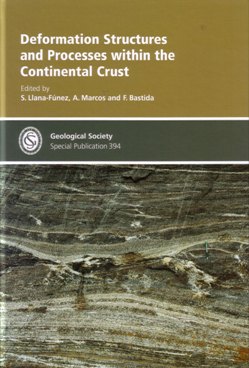Deformation Structures and Processes within the Continental Crust
 This Special Publication volume, a worthy contribution to its field, consists of twelve papers, presented in three themes, developed from a ‘Deformation Mechanisms, Rheology and Tectonics Meeting’ held at the University of Oviedo in late 2011.
This Special Publication volume, a worthy contribution to its field, consists of twelve papers, presented in three themes, developed from a ‘Deformation Mechanisms, Rheology and Tectonics Meeting’ held at the University of Oviedo in late 2011.
The first four papers are presented under the theme of ‘Structures: shear zones and folds’ and provide novel and interesting approaches to quantifying, analysing, and differentiating strain within single and multiple generations of ductile structures. Lisle (2013) reviews new and existing methods for analysing finite strain in shear zones and presents a new algebraic and, graphical method to quantifying finite strain where volume change during deformation is considered.
Frehner & Exner (2013) apply a numerical approach when considering the refraction patterns in axial foliation (fans) to understanding the distribution of strain within buckle folds and make important observations regarding the rheological sensitivity of layers to recording strain. Calvín-Ballester & Casa (2013) employ geometrical approaches to differentiate the development of two superimposed thrust-fault - cleavage-forming events formed during progressive orogenic deformation in a foreland fold-and-thrust belt. Weisheit et al. (2013) utilise a range of thermochronological data coupled with structural analysis and reconstruction to demonstrate the development of a crustal-scale fold occurred over two deformation cycles spanning ~200Ma.
The next five papers are presented under the theme of ‘Magmatism and Structure’ and provide examples of how the development of structural features is frequently linked to magmatic activity and hence often amenable to geochronological dating. Rutter et al. (2013) uses 40Ar/39Ar dating techniques on pre- and syn-tectonic volcanism to constrain the duration of the main movement along a crustal-scale transform fault system. Similarly, Rodríguez-Méndez et al. (2013) date diabase dykes linked to basin-wide magmatism to better constrain the changing geodynamic regime heralding the break-up of Pangaea. Magma often utilises crustal-scale structures as conduits for ascent and emplacement and Oriolo et al. (2013) using detailed structural, kinematic, and geophysical data shows the importance of pre-existing cross-strike structures associated with flat-slab segments as reactivated conduits for magmatism; a significant observation for economic geologist.
Caggianelli et al. (2013) model the thermal effect of a magmatic intrusion on the rheology of the host rocks suggesting that while multiple intrusions within the crust would be require to sustain mechanical weakening, a single intrusion maybe sufficient to nucleate a normal fault that could allow further thermal weakening through crustal extension. Morgan et al. (2013) highlight deficiencies in the ‘Titanium-in-Quartz’ geothermometry associated with Ti heterogeneity and its chemical activity during metamorphic conditions.
The final three papers are presented in the theme ‘Microstructures and Rheology’ and illustrate the effect of crystallographic preferred orientation (CPO) of mineral grains and recrystallisation on mechanical behaviour of rocks at the micro-scale. Liana-Fúnez & Rutter (2014) experimentally explored the relation between CPO of calcite in limestone during ductile deformation and localisation of strain geometries. Similarly, Piazolo & Jaconelli (2013) consider the rheology of sillimanite aggregates in gneiss defined by slip-systems at high-temperatures related to the aggregates CPO. A numerical approach by Borthwick et al. (2013) explores the effects of recovery recrystallisation in rocks close to their deformation temperatures showing that microstructures can be modified at temperatures lower than experienced during peak deformation.
Reviewed by Mark N. Burdett
DEFORMATION STRUCTURES AND PROCESSES WITHIN THE CONTINENTAL CRUST
by S LLANA-FÚNEZ, A MARCOS, & F BASTIDA (Eds) 2014 Geological Society of London Special Publication 394 ISBN 978-1-86239-627-2 239pp (hbk)List Price: £90 (Fellows £45; Other societies £54)